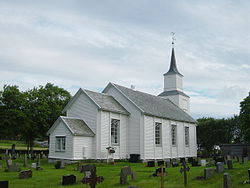|
Hustad (municipality)
Hustad is a former municipality in Møre og Romsdal county, Norway. Hustad existed as a municipality from 1918 until its dissolution in 1964 when it was merged into Fræna Municipality. The 125-square-kilometre (48 sq mi) municipality encompassed most of the northern part of the Romsdal Peninsula in what is now Hustadvika Municipality. The administrative centre of the municipality was the village of Hustad where Hustad Church is located.[2] HistoryThe municipality of Hustad was established on 1 July 1918 when the larger Bud Municipality was divided into two separate municipalities: Bud (population: 1,397) in the west and Hustad (population: 2,062) in the east.[2][3] During the 1960s, there were many municipal mergers across Norway due to the work of the Schei Committee. On 1 January 1964, there was a merger involving Hustad Municipality (population: 2,196) in the north, Bud Municipality (population: 1,610) in the west, and Fræna Municipality (population: 3,430) in the south, forming a new, larger Fræna Municipality.[2][3] NameThe municipality (originally the parish) is named after the old Hustad farm (Old Norse: Húsastadðir) since the first Hustad Church was built there. The first element comes from the word hús which means "house". The last element is the plural form of stadðr which means "place" or "village".[4] GovernmentWhile it existed, this municipality was responsible for primary education (through 10th grade), outpatient health services, senior citizen services, unemployment, social services, zoning, economic development, and municipal roads. During its existence, this municipality was governed by a municipal council of directly elected representatives. The mayor was indirectly elected by a vote of the municipal council.[5] Municipal councilThe municipal council (Herredsstyre) of Hustad was made up of 17 representatives that were elected to four year terms. The party breakdown of the final municipal council was as follows:
See alsoReferences
|
|||||||||||||||||||||||||||||||||||||||||||||||||||||||||||||||||||||||||||||||||||||||||||||||||||||||||||||||||||||||||||||||||||||



